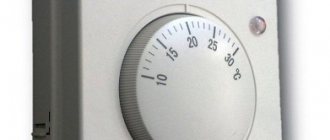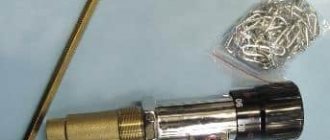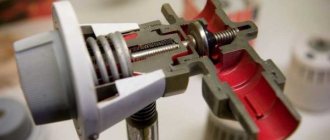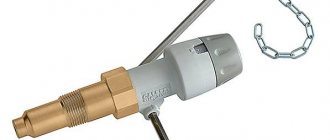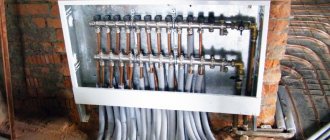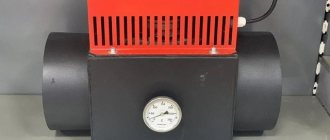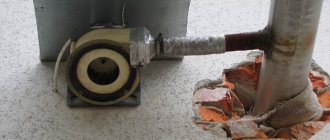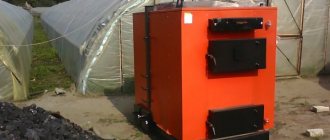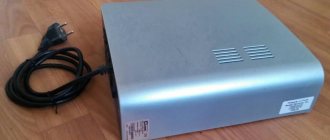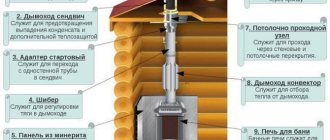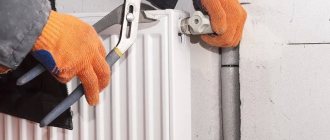The design of any gas or electric boiler contains monitoring and control elements that monitor the temperature of the coolant at the outlet. But in older or inexpensive models, such components have a primitive design that only allows you to turn the heating on and off. Homeowners who want to optimize the operation of their heating system equip it with remote temperature controllers. Due to the high price of factory-made thermostats, they are made independently.
Review of popular models and manufacturers
The market for advanced gas equipment and related elements includes automation from both domestic and foreign manufacturers.
According to the principle of operation, all devices are absolutely identical, but in terms of design there are significant differences between them. The cost of modules varies over a wide range. Simple mechanical products with a minimum of functions belong to the budget class and are sold at the lowest price. Advanced electronic panels are valued much higher, but provide the user with more extensive options for individual settings and control of operation.
Programmable electronic devices are considered luxury. They enable the owner to set an operating plan for the equipment for a long period of time, taking into account seasonal weather conditions and the current outside air temperature.
No. 1 - automatic EUROSIT 630
The automatic non-volatile unit EUROSIT 630 produced by the Italian company Sit Group (Eurosit) occupies a leading position in the market in terms of sales.
It is considered universal and works effectively with parapet and floor-standing boilers with a power from 7 to 24 kW. Switching on/off, igniting the pilot burner and setting the desired temperature are carried out using one handle with a button.
The product is characterized by a high level of reliability, can withstand significant operating loads and has extensive functionality. The structural elements are “hidden” in the housing, to which sensor cables and other connecting tubes are routed.
Inside the unit there is a cut-off valve, a spring valve and a pressure regulator. The gas supply is carried out from below or from the side according to the user’s wishes. In terms of cost, the unit is included in the budget category.
No. 2 - Honeywell 5474 module
The Honeywell 5474 device is manufactured by the German concern Honeywell, which has been specializing in the development and sale of various types of automation for more than a hundred years. Works correctly with domestic gas boilers with a power of up to 32 kW.
The Honeywell 5474 automatic system is equipped with a basic set of control functions that guarantee efficient operation of the boiler with absolute safety for users.
In automatic mode, the product maintains the specified coolant temperature (from 40 to 90 degrees), turns off the boiler in the event of a fuel supply cutoff, lack of draft at the required level in the chimney, reverse draft occurs, or burner extinguishment.
No. 3 - premium automation from Honeywell
In addition to inexpensive budget models, Honeywell also produces other types of automatic equipment, for example, luxury chronothermostats of the premium ST series or programmed thermostats Honeywell YRLV430A1005/U.
These electronic panels allow you to set the heating equipment the most detailed and precise settings, up to changing the temperature several times a day depending on the time of day, weather conditions and personal wishes.
No. 4 - Orion device
The Orion automatic device is manufactured in Russia. The device includes a piezoelectric ignition and a draft sensor.
The device turns off the gas in case of random extinguishing of the burner or lack of the required draft. When the room temperature drops, the thermostat activates the fuel supply and the boiler resumes operation.
The transition to the flame reduction mode when a certain (user-specified) temperature is reached occurs automatically and allows you to save fuel resources.
Advantages and disadvantages
Most household heating and hot water boilers using solid fuel are manually loaded. Pellet and pyrolysis units with a long cycle are usually 4-8 times more expensive for the same power, so not everyone can afford it.
Depending on the model and volume of the combustion chamber, firewood/coal must be added to the firebox every 3...6 hours, which is not very convenient, especially at night. In a boiler with automation, this period can be increased by 1.5...2 times.
- The heating unit operates all night on one load of fuel, maintaining a comfortable temperature (without excessive heating and cooling).
- the boiler returns to operating mode faster - for example, after idle time, when you want to quickly warm up the room.
- The optimal range is set for the DHW circuit so as not to scald yourself with boiling water or wash in cool water.
- Possibility of remote control (via smartphone applications, Internet: on the way home, activate the heating system so that the premises are warmed up when you arrive).
- Increased operational safety: even if there is no one at home, the automation will turn off the boiler, bring it to minimum mode or turn it off completely, or increase the water flow in order to more intensively remove heat from the heat exchanger.
The main disadvantage of all electronic controllers is their dependence on power supply. If the light goes out, the automation (as well as the pump and fan) will stop working. Even a working boiler will stop heating the room, or will function at a minimum - as in a system with natural coolant circulation. To prevent this, backup power supplies with batteries are used that can power the electronics and motors from 30 minutes to several hours.
Solid fuel boiler problems
Photos of automation for solid fuel boilers
Until automation for solid fuel boilers appeared, this equipment was characterized by serious problems.
- The constant presence of a person near the boiler was required to maintain the combustion process. It is necessary to add fuel every few hours so that the firebox does not go out and the house remains warm.
- Before each new loading of solid fuel, the ash pan and the firebox itself must be cleaned. This procedure gives a minimum of pleasant sensations and takes a lot of time. And the process itself is very dirty.
- To control the combustion processes, only one means was available - a blower damper. By opening or closing it manually, the combustion of solid fuel was regulated.
What did automation give?
Automation for solid fuel boilers, which has become widely available, has brought with it a lot of advantages. Among them, we note the most significant:
- The coolant temperature is set by the user and maintained automatically;
- The level of solid fuel consumption is reduced with a simultaneous increase in the efficiency of the boiler;
- The labor intensity of maintenance is reduced. This is largely due to the fact that in automated solid fuel boilers the frequency between maintenance has increased significantly. Usually the ash pan and firebox are cleaned once every 1-2 weeks;
- The level of safety during operation of a solid fuel boiler has noticeably increased.
How to setup
As a rule, all devices have instructions from the manufacturer, which detail step-by-step instructions on how to set up a newly installed device.
In general, all steps boil down to the following points:
- First, the heating system must be filled with coolant. At the same stage, the presence of air cavities inside the system is checked. They shouldn't exist.
- Now the circulation pump is activated. Here you need to make sure that it adjusts the coolant without any obstacles.
- After the circulation pump is started, it is necessary to check the thermostat indicators, where temperature and pressure indicators will be given. All these indicators must be within the limits established in the instructions.
- If all indicators are normal, then you can start ignition. Here you should fulfill all the requirements specified in the instructions without exception, since automation devices from different manufacturers release flames into the combustion chamber in completely different ways and have a number of their own characteristics.
- When everything is completed, you should throw a certain amount of fuel into the firebox (this amount is usually indicated in the instructions) and set the necessary parameters. It is recommended to add fuel several times and check the instrument readings to ensure they do not go beyond normal limits.
Brands
Today, the most well-known manufacturers of such remote monitoring systems are the following companies:
- Vaillant;
- Buderus;
- Protherm;
- Viessmann;
- Evan;
- Xital.
Installation and connection of the system are not too complicated, so you can handle it yourself.
At the same time, VIESSMANN offers heat generators already equipped with special units and compatible controllers. Devices from . They are quite functional and the gsm heating control “Xital” provides, for example, the possibility of using 2 SIM cards and the presence of a reliable algorithm that guarantees their smooth operation.
The video instructions cover how to install the Xital system yourself.
Which is better - a smoke exhauster or a blower?
When the traction turbine is integrated into the heat generator by the manufacturer, such questions do not arise. Adding an exhaust fan to a conventional direct combustion boiler is another matter. You need to understand that in this case, the smoke exhauster solves only 1 problem - creating a vacuum in the firebox and increasing draft. There are a number of negative points here:
- Without an electronic control unit, performance will have to be adjusted manually. Automatic maintenance of coolant temperature is excluded.
- When air is supplied through the open ash chamber door, the fan will force the boiler to operate at maximum. Setting up a long burn mode will not be easy.
- In the event of an emergency stop of the impeller, fuel combustion will not stop, since gases pass freely through the volute or the body of the smoke exhauster. Air enters the firebox, increasing the likelihood of overheating.
- The impeller and internal surfaces of the unit become covered with soot, which must be removed. The rate of sticking depends on the moisture content and resin content of the wood.
Blowing machines always work in conjunction with a controller, so the problems listed above do not exist:
- the blower changes performance and turns off at the command of the control unit, the coolant heats up to the set temperature;
- during the combustion process, the ash pan door is hermetically closed, air is supplied through a separate channel;
- when there is a power outage, the air channel is automatically closed by a gravity damper;
- the impeller blades do not come into contact with hot smoke and soot.
Now let’s compare the cost of a traction fan and a blower fan, not taking into account the price of the controller. A smoke exhauster for a TT boiler up to 30 kW will cost 90 USD. e., supercharger - 60-65 cu. e. The difference is due to the design features of the exhaust unit - hot gases should not overheat the electric motor, plus the impeller is made of metal (when pressurized, it is made of plastic).
Behind the mounting flange of the unit there is a small impeller designed to cool the electric motor
The installation complexity of the units is approximately the same. Installation of the discharge volute involves cutting out an opening in the ash pan door, and the smoke exhauster involves disassembling or cutting out the pipe. It is easier to install a roof hood, but you will have to pull a long cable.
Brands of solid fuel boilers made in Russia
Analysis of technical characteristics will help to get a general idea of long-burning solid fuel boilers. Consumer reviews on independent forums provide an objective assessment of domestic developments.
Table 1. Solid fuel boilers Zota Mix and Pellet produced by the heating equipment and automation plant (Krasnoyarsk):
Table 1. Solid fuel boilers Zota Mix and Pellet produced by the heating equipment and automation plant (Krasnoyarsk)
- The efficiency of boilers of the Zota Mix model range is 80%, Pellet – 90%;
- Zota Mix combined steel solid fuel boilers operate on any type of fuel (liquefied or natural gas, electricity, liquid fuel);
- the combustion chamber and ash box are located inside the water jacket;
- an adjustable chimney damper, a mechanical draft regulator and air suction by an ejector installed in the combustion door ensure complete combustion of fuel with minimal draft;
- the outer surface of the body is coated with an anti-corrosion polymer composition;
- a removable door behind the front panel provides access for cleaning the flue;
- possibility of repair.
Zota Mix boiler design
- you need a supply of fuel and a place to store it;
- costs for delivery, unloading and storage of firewood, coal, briquettes;
- reduction in the productivity of Zota Mix boilers when using low-quality fuel (brown coal by 10÷20%, raw firewood by 60÷70%);
- for Zota Mix - manual loading of fuel, cleaning of the ash pan, firebox walls, flue ducts and smoke pipe;
- mandatory preparation of boiler water (hardness up to 2 mEq/l);
- installation in a separate room;
- For boilers of the Zota Mix line, it is necessary to install a heat accumulator, a smoke exhauster, and a boiler.
Table 2. Combined solid fuel devices with a water circuit (AKTV). (Novosibirsk city):
Table 2. Combined solid fuel devices with a water circuit (AKTV). (Novosibirsk city)
- budget option for solid fuel boilers with a water circuit for the home (price 11,000÷25,000 rubles);
- compact size;
- the water heat exchanger covers the firebox from all sides (except the front);
- retractable ash drawer;
- mounting socket for draft regulator;
- the ability to connect to a chimney of any configuration;
- the steel heat exchanger allows for simplified connection to the heating system (without mixing);
- The design is adapted to operate on gas and electricity.
Boilers "Karakan" from
- outdated design, primitive automation of low quality;
- The technical characteristics declared by the manufacturer (power, heated area and efficiency) according to consumer reviews do not correspond to actual indicators.
Table 3. Solid fuel pyrolysis boilers Bourgeois & K from NPO TES LLC (Kostroma):
Table 3. Solid fuel pyrolysis boilers Bourgeois & K from NPO TES LLC (Kostroma)
- ensures stable combustion of fuel of any grade and degree of humidity;
- efficient operation of the boiler from one fill for 8 hours;
- economical fuel consumption;
- compatibility of the generator with natural or forced circulation systems;
- an environmentally friendly unit, the fuel undergoes a complete combustion cycle without producing harmful emissions into the atmosphere;
- The design of the firebox ensures reaching an effective operating mode in 40 minutes.
Solid fuel pyrolysis boilers "Bourgeois & K"
- complex installation: the connection must be made by employees of specialized enterprises that have a license for this type of activity (otherwise the manufacturer’s warranty does not apply to the unit);
- manual fuel filling and combustion chamber cleaning;
- heavy weight.
Installation and operation of solid fuel boilers must be carried out in accordance with fire safety rules
For heating a country house. In a garage or greenhouse, it is possible to make long-burning solid fuel boilers with your own hands. Videos with materials on this topic can be found on the Internet. But remember that the main condition for using heating equipment is fire safety. And only a certified manufacturer can guarantee the fulfillment of this condition under proper operating and installation conditions of the equipment.
https://youtube.com/watch?v=3sfw2qpCMrY
https://youtube.com/watch?v=1z6OOs3WdH4
A few important points
On average, about a hundred MB of Internet traffic is required monthly to operate a GSM unit. Errors and interruptions in operation can lead to system failures. Therefore, you should carefully monitor the regularity of payments or connect to a tariff that provides unlimited Internet use.
Another important point is that third-party SMS can negatively affect the operation of the heating system. Therefore, it would be useful to contact the operator and ask to disable all advertising mailings. The best way out of this situation is to buy and use a new SIM card, the number of which no one knows. This will help eliminate a significant part of unformatted SMS, which can cause a failure.
GSM control of the heating boiler via SMS occurs using an application in which you can monitor the status of your heating
There are models that can remotely control a heating boiler both via the Internet and via SMS. Such automation can operate in several modes:
- Auto. A mode in which the GSM heating controller is capable of ensuring the execution of a list of installed programs by analyzing information received from external sensors.
- SMS. When receiving messages sent by the home temperature control sensor via the phone, the controller can reconfigure the heating system in accordance with these parameters.
- Warning. Sending alarm SMS messages to the user in the event of emergency situations (violation of the tightness of water supply systems or gas leaks).
- Providing remote control of other systems and devices, including hot water supply, checking the lighting system, etc.
A very interesting option. Such equipment is more expensive, but makes it possible to choose a more convenient and/or more reliable operation option.
How to make simple automation with your own hands: tips and tricks
It’s not difficult to set up the simplest automatic control of a solid fuel boiler with your own hands. The most important thing here is to buy the right equipment. You understand that you will not be able to make all the necessary devices, and the equipment itself, by and large, does not cost that much. That is why, when talking about homemade automation for a solid fuel boiler, in most cases we mean buying ready-made equipment and installing it yourself. Do-it-yourself installation is quite simple, and you can imagine this whole process in the form of the following sequence of work.
- Fan installation. This is the most difficult part of the work, especially if the boiler design does not provide for automatic control. In such a situation, you will have to make a hole for air injection yourself and install a turbine on it. In principle, this is not difficult for a technically competent person - the main thing here is not to forget about the heat-resistant seal between the fan and the door, and everything else is trivial. The fan is screwed into place through pre-drilled holes in the blower door.
- Connecting the controller. There is also nothing complicated here - when purchasing an automation kit, you are buying some semblance of a construction set, which is assembled according to the scheme. No exception is the switching of wires, which, among other things, are equipped with connectors that cannot be confused.
When the automation is assembled, there is only one thing left to do - install a temperature sensor. As a rule, in almost all models of modern solid fuel boilers a special place is provided for it. If this is not available, then you can attach the sensor directly to the supply pipeline - in the simplest version, this is done using metallized heat-resistant tape. The sensor is simply wound onto the pipe.
Homemade automation for a solid fuel boiler photo
This concerns the electronic control of a solid fuel boiler. But besides this, there are also mechanical systems that regulate the intensity of fuel combustion by simply opening and closing the boiler ash door. How such automatic control works is, one might say, quite simple. A mechanical thermoelement is installed in the boiler (in a specially designated place) - when heated, the plate built into it changes its shape and configuration, which sets a special lever in motion. In turn, this lever is connected to the ash door by a cable or chain, which transmits the movement of the lever directly to the door, as a result of which it opens and closes, depending on the temperature of the coolant in the boiler.
Which automation is better for solid fuel boilers? Mechanical or electronic? Both principles of controlling fuel combustion in a boiler have their drawbacks. Electronic systems do not work without electricity - in order to ensure the operation of the boiler during power outages, you will additionally have to purchase an uninterruptible power supply unit. The mechanics often jam. In addition, the choice of one or another automation system for a solid fuel boiler can also be influenced by its cost - mechanics will cost less.
Author of the article Alexander Kulikov
Installation and configuration
The installation process of an automatic control system includes:
- Connection of the blower fan. As a rule, the turbine is located on the lowest door of the boiler, where the damper is located. But there are models of units where it is installed on the side wall, or in a special place on the top of the boiler, it all depends on the design features. Everything is simple here: the damper is removed, and a fan is put in its place; four bolts are used for fastening. If there are no holes for mounting, they need to be drilled. For fans with a damper, installation is carried out in such a way that the damper is closed when the fan is off.
- Installation of the controller. First of all, you need to decide on the place where the device will be installed. The main requirement is that it should not heat up. On models without a hob, the automation is mounted on top. If the design of the unit allows, you can install the unit on the side wall. Don't forget about the length of the cables.
- Connecting the temperature sensor. A correctly installed temperature sensor will ensure the normal functioning of the entire control unit. If the model does not have a special place for the sensor (hole parameters: diameter 10 mm, depth 60 mm), then it can be mounted on the output metal pipe. A clamp is used as a fastening material; it can be supplied with the device.
- Connecting connectors. To do this, you need to connect the turbine connector to the control unit connector. Finally, you need to connect the device’s network cable. The automation is ready to perform its functions.
Advantages and disadvantages
Most household heating and hot water boilers using solid fuel are manually loaded. Pellet and pyrolysis units with a long cycle are usually 4-8 times more expensive for the same power, so not everyone can afford it.
Depending on the model and volume of the combustion chamber, firewood/coal must be added to the firebox every 3...6 hours, which is not very convenient, especially at night. In a boiler with automation, this period can be increased by 1.5...2 times.
- The heating unit operates all night on one load of fuel, maintaining a comfortable temperature (without excessive heating and cooling).
- The boiler returns to operating mode faster - for example, after idle time, when you want to quickly warm up the room.
- The optimal range is set for the DHW circuit so as not to scald yourself with boiling water or wash in cool water.
- Possibility of remote control (via smartphone applications, Internet: on the way home, activate the heating system so that the premises are warmed up when you arrive).
- Increased operational safety: even if there is no one at home, the automation will turn off the boiler, bring it to minimum mode or turn it off completely, or increase the water flow in order to more intensively remove heat from the heat exchanger.
The main disadvantage of all electronic controllers is their dependence on power supply. If the light goes out, the automation (as well as the pump and fan) will stop working. Even a working boiler will stop heating the room, or will function at a minimum - as in a system with natural coolant circulation. To prevent this, backup power supplies with batteries are used that can power the electronics and motors from 30 minutes to several hours.
Price and reviews
The cost of an automated system is influenced by the technical indicators and functionality of the device. Thus, the price of the simplest mechanical model varies within 1.5 thousand rubles.
The price range of more progressive options is from 25,000 rubles to 100,000 rubles. The more expensive the model, the higher the ergonomics of the heating system will be, and the resource consumption will be correspondingly lower. Therefore, it is more advisable to give preference to more expensive options.
Reviews:
Nikolai Viktorovich. “The control unit from the Krypton company is one of the best devices today. It is distinguished by the quality of its components; the kit includes a sensor, cords for connecting to the fan and pump, a clamp, and adapters. A reliable device from a Polish manufacturer.”
Fedor. “On the recommendation of a friend, I installed the ATOS automatic, its performance characteristics are excellent.”
Anatoly Yurievich. “The Proton automation surprised me with the presence of additional components in the package (a clamp for attaching the sensor, a stand for the unit, self-tapping screws). The device is efficient, reliable and easy to use. ”
Types of gas heating boilers
Gas boilers are divided into two main groups:
- Wall-mounted;
- Floor-standing.
The separation is determined by the thermal power of the equipment. Wall-mounted boilers usually have a productivity of no higher than 30 - 35 kW. An increase in productivity entails an increase in the total mass of the product, which is problematic to install using a wall method.
Therefore, boilers with increased power are produced in a floor-standing version. They can have a power of up to several hundred kW.
Wall-mounted boilers, in turn, are divided into two subtypes:
- Single-circuit;
- Dual-circuit.
Single-circuit devices work only on the heating system; for them, the operating algorithm described in the previous section is correct. Double-circuit models have two heat exchangers - a heating system and a hot water production complex.
Switching the coolant flow pattern in a double-circuit boiler is done by a three-way valve. When cold water flows through the DHW heat exchanger, the flow sensor commands the valve to turn on coolant circulation through the hot water heat exchanger.
In this case, the coolant stops moving through the heating system. The DHW circuit has average power ratings; with large and constant consumption of hot water, the cooling of the radiators becomes noticeable.
The next important design principle of gas boilers is the smoke removal system. It comes in two types:
- Forced smoke removal;
- Smoke removal due to natural draft.
Forced smoke removal is typical mainly for wall-mounted boiler models. Smoke removal and air intake are realized using a built-in fan through a coaxial or separate chimney.
The diameter of the smoke removal system pipes usually does not exceed 100 - 125 mm, the kit has compact overall dimensions. Boilers with such a system are called heat generators with a closed combustion chamber.
Removal of combustion products by natural draft is carried out from powerful floor-standing models. This requires the construction of a chimney. Boilers with such a system are called atmospheric, with an open combustion chamber. These boilers take air for the combustion process from the boiler room. For high-quality operation of the equipment, a ventilation system is necessary.
Floor-standing boilers differ in the level of complexity of the automation system. Modern models are equipped with high-quality automation units and are mainly energy-dependent.
Some models of floor-standing boilers have mechanical automation based on the operation of a bimetallic plate. When the coolant is heated to a given temperature, the plate bends due to heating and closes the gas supply; when it cools, it opens. Such floor-standing models are completely energy independent.
In addition to the atmospheric principle of smoke removal, floor-standing boilers are equipped with fan (pressurized) burners. The combustion process occurs more intensely due to the increase in excess air. Such boilers have increased power and efficiency and are units with a closed combustion chamber. Most often, industrial steam boilers are equipped with pressurization.
A number of models of floor-standing boilers have a secondary hot water production circuit or a built-in DHW boiler. It is possible to connect an indirect heating boiler to other models.
The choice of type (and therefore device) of a gas boiler largely depends on the method of circulation of the coolant in the heating system.
How to choose the right boiler connection diagram
In order to keep the house warm, it is not enough to know what heating schemes are available with a solid fuel boiler. Craftsmen who have been creating heating systems for many years give the following recommendations:
- When creating a drawing of a heating circuit for a solid fuel boiler, you should first familiarize yourself with the types and operating principles of such heat generators. This can be a constant or long-burning heater, a pyrolysis or pellet unit, or a buffer. Each of these devices has its own operating criteria, which may be disadvantages for some, and advantages for others.
- To get an ideal heat supply scheme, you need to be able to combine the functioning of the boiler with the tank, since this element accumulates thermal energy. This is justified by the fact that the element heating the water can change its temperature in the range from 60 to 90 degrees. There is no constant indicator. Since solid fuel boilers are inert devices, this distinguishes them favorably from gas, diesel and electric analogues.
- When choosing a heating scheme, you need to objectively assess the risk of power outages. If there are frequent power outages in the area, then a system with a water pump will not only not pay for itself, but may quickly fail. Therefore, it is better to choose a type of heating with natural circulation.
- When choosing a piping, it is worth considering in advance the safety lines between the boiler and the tank. They are located at the points of the inlet and outlet pipes so that they are as close as possible to the water heater. Also, to achieve maximum effect, you need to try to keep the distance between the boiler and expansion tank to a minimum. But it is no longer possible to install safety valves or taps here.
- If a scheme with a pump was chosen, then it is installed on the return pipe, as close as possible to the heat generator. Thus, even if the lights are turned off and the pump stops working, the water will continue to move along the circuit, that is, minimal heat will be retained. The device must be installed along a bypass route. Only then will it be possible to disconnect it from the network (if necessary), and shut off the circuit itself using taps.
- There is such a thing as bypass. These are jumpers with taps that are placed between the supply line and the return pipe. This arrangement facilitates the return of “extra” hot water when the volume changes through the thermostat.
- A stainless steel valve must be installed in the chimney pipe. Since there is moisture in the smoke, albeit in small quantities, it is this that can provoke the destruction of the internal part.
Tying is a process that deserves special attention. Therefore, they design and install it only if they have complete confidence in their abilities. Nikolay Avramenko, 51 years old
Energodar
Nikolay Avramenko, 51 years old, Energodar
Having read the article, I would like to add my note. The topic of operational characteristics of solid fuel boilers was touched upon here. It was indicated that they have such a feature as high inertia. I would like to say that this phenomenon is not typical for pellet boilers. This is due to the fact that such devices have a burner that receives wood pellets in portions. Therefore, when the supply of raw materials stops, the flame immediately goes out. Although such boilers are not so cheap.
Anton Abramov, 29 years old, Omsk
At one time, I was interested in the work of solid fuel boilers, as they offered me a position related to this area. I would like to leave a few words about the thermostat and its regulatory features. You need to understand that when a certain temperature is set, for example, at 85 degrees, even though the damper is closed, the burning and smoldering continues. Because of this, the water still heats up a couple of degrees, and only then it will be established accurately. Therefore, you should not turn the thermostat back and forth, otherwise this may lead to breakdown of the entire system.
Nikita Karpenko, 37 years old, Arkhangelsk
When we built a house outside the city, we planned to live there all year round. The time came when it came to heating, and I settled on a closed-type system with natural circulation. Firstly, it was quite easy for me to create it with my own hands, and secondly, we were already a little limited in money. I didn’t have any particular problems with the installation, but when the first cold weather arrived, I realized that there was clearly not enough heat for the house. So at school, I was quite good at physics, and I realized that heat is “lost” in areas where the pipes were left open. Taking a roll of mineral wool, I wrapped all the pipes that run in open areas. Literally by the end of the first day, our family felt a significant warming in the rooms. Therefore, you need to remember such moments.
How to setup
As a rule, all devices have instructions from the manufacturer, which detail step-by-step instructions on how to set up a newly installed device.
In general, all steps boil down to the following points:
- First, the heating system must be filled with coolant. At the same stage, the presence of air cavities inside the system is checked. They shouldn't exist.
- Now the circulation pump is activated. Here you need to make sure that it adjusts the coolant without any obstacles.
- After the circulation pump is started, it is necessary to check the thermostat indicators, where temperature and pressure indicators will be given. All these indicators must be within the limits established in the instructions.
- If all indicators are normal, then you can start ignition. Here you should fulfill all the requirements specified in the instructions without exception, since automation devices from different manufacturers release flames into the combustion chamber in completely different ways and have a number of their own characteristics.
- When everything is completed, you should throw a certain amount of fuel into the firebox (this amount is usually indicated in the instructions) and set the necessary parameters. It is recommended to add fuel several times and check the instrument readings to ensure they do not go beyond normal limits.
Strapping scheme
A solid fuel unit is usually connected to a boiler that runs on a different type of fuel. This is usually an electrical unit.
An electric one is installed parallel to the solid fuel stove. This is the so-called auxiliary element. Its role is as follows: if, for example, the owners are not in the house for a long time, and the solid fuel boiler has run out of fuel, then the auxiliary element, in this case, the electric unit, automatically comes into working condition. It maintains positive temperatures. More on how it all works.
First, the coolant under pressure from the circulation pump is supplied to the boiler, passing through which it heats up. Next, the coolant enters the radiator, where movement follows the principle of natural circulation. Then it enters a special boiler, inside of which there is a coil that is immersed in water. The coolant, passing through the coil, heats it, as a result of which the water heats up. Thus, the residents of the house are provided with hot water.
After the boiler, the coolant again enters the radiators and underfloor heating coils. But before that, he must pass a special crane. If the temperature of the coolant corresponds to the established norm, then the tap opens and the coolant circulates through the floor coils, and if the temperature is higher than normal, the tap closes.
Features of choice
Since the boiler is not supplied with a regulator from the factory, when choosing a heating device you need to pay attention to the presence of a sleeve for the accessory on top of the body. The latter is mounted inside the water jacket and can be in three positions - side, front, top
The second requirement for the boiler is the ability to open the ash pan door upwards. Without this feature, the regulator cannot be configured.
In addition, it is recommended to consider the following parameters:
- the power of the device must be sufficient to easily lift the ash pan door;
- desired range of maintained temperatures (usually 60-90° C);
- the external thread of the regulator matches the internal thread of the sleeve;
- The angle of rotation of the lever allows you to fully open and close the door.
The design of boilers is usually such that the action of the regulator is limited in space, and this must be taken into account when choosing the location for installing the heating system. However, there are heating devices in which it works in any position
Types of traction fans
Several types of smoke exhausters are sold for solid fuel boilers and wood-burning fireplaces:
- boiler (the design is discussed above);
- centrifugal channel;
- overhead;
- fireplace/stove (aka roof).
Varieties of duct smoke exhausters, some models are equipped with temperature sensors. The duct fan is distinguished by its own housing with two connecting flanges or pipes.
The unit is installed vertically or horizontally into the gap in the chimney duct. The device and principle of operation are similar to the operation of a boiler smoke exhauster. The overhead smoke exhauster for a domestic boiler is equipped with a semicircular platform and clamps-ties. Installation is carried out on a vertical section of the chimney (uninsulated):
- An opening is cut out in the pipe using a paper template.
- The impeller of the traction machine is inserted into the hole, and the platform with the electric motor is pressed to the surface with clamps.
- The connection is sealed with an asbestos cord glued to the inside of the installation site of the smoke exhauster.
Electric fireplace hoods are mounted on the head of a brick chimney and secured with spacer bolts. The power cable is laid through a pipe and introduced into the room next to the home stove.
To choose a traction machine, you need to focus on 3 criteria:
- heat generator power, smoke exhauster models are designed for boiler performance up to 20, 30, 50 and 100 kW;
- installation point - on the boiler itself, pipe or head;
- for overhead models – the diameter of the uninsulated flue.
Overhead (left) and roof-mounted smoke exhauster (right)
Features of installing automation on the boiler
The installation of automation on a solid fuel boiler should be carried out by a professional technician. The procedure has quite a few nuances that must be taken into account. Incorrect installation will make it impossible for the unit to function normally and all efforts to replace the control unit will be in vain. The cost of the service is very low, so you won’t be able to save a lot of money on this. But the damage from incorrect actions and subsequent breakdown will be noticeable.
After completing installation work, correct calibration must be carried out. You can do this yourself using the included instructions, or seek help from the specialist who carried out the installation. The automation for the boiler is configured according to the following scheme:
- 1. First, you need to fill the heating system with coolant and bleed all the air out of it so that there are no plugs that will interfere with normal circulation. It won't be difficult at all to do this.
- 2. Then you need to start the circulation pump and check that it begins to drive water through the system without any obstacles.
- 3. When the water in the system begins to circulate, you need to check the readings on all emergency thermostats, as well as the water level and its pressure in the system. All indicators must be within acceptable limits.
- 4. Now you can proceed directly to ignition. Each automation has its own characteristics of starting the flame into the combustion chamber, so at this stage you must strictly adhere to the requirements of the operating instructions.
- 5. When ignition is completed, you need to add the specified amount of fuel into the firebox and set the desired operating parameters. Occasionally you will need to add fuel and check the readings of control devices with the norm.
Gas boiler automation repair
If the boiler automation was purchased together with the boiler, it is configured at the manufacturer, then its operation is very reliable throughout the entire period stated by the equipment manufacturer.
Problems occur more often on European equipment, which are caused by the instability of Russian engineering systems. The most common breakdowns occur in the igniter, shut-off valve, electronic board and temperature sensors.
What you can do yourself
If the safety automation along with the boiler is under warranty, then it is better to contact a service center in case of any breakdown.
Many manufacturers in EU countries require equipment to be submitted for service only through branded centers and even after the end of warranty service. In these situations, it is not recommended to perform independent repairs. It is also unacceptable to change electronic control boards yourself.
Basic malfunctions and their repairs
Malfunctions of automatic gas boilers, which are most often encountered in practice, compiled from reviews of users and specialists in the field of maintenance and repair of household boilers.
Causes of the malfunction:
- The torch on the igniter does not light, the nozzle or gas filter is clogged, clean it from dirt and blow it out.
- A gas valve is defective, if it is under warranty, it is preferable to replace it with a new one at a service center.
- There is no contact between the cable and the traction sensor, the cable is disconnected and the contacts are cleaned.
- The draft sensor does not work; if the contacts are short-circuited and the cable is disconnected, the torch does not go out; it needs to be replaced with a new one.
- The thermocouple gives -EMF less than 0.3 mV; the thermocouple needs to be replaced.
Automation of boilers today is not a whim of the owner, but a requirement of standards for the safe operation of such units. It is achieved by using a variety of control and protection means: mechanical, hydraulic, pneumatic, electronic and computer, which are often combined depending on the level of automation and its cost.
The use of automatic systems in boiler operation increases their safety and ensures the most energy-efficient operating modes.
Comfort Eco
- Manufacturer: Poland;
- Power supply: 220V/50Hz;
- Connected pump power: up to 300W;
- Fan power: up to 300 W;
- Coolant temperature setting range: 35-80°C;
- Temperature measurement accuracy: 1°C;
- Room temperature setting range: 20-45oC;
- Estimated cost: 7900-8200 rub.
Compact control unit mounted on the boiler body with simple controls and a two-digit dial. Allows you to adjust the operation of the boiler depending on the set target temperature in the heated room. Provides boiler protection from overheating and freezing.
